Ask coaching clients 4 laser-focused questions that surface their main problem, breakthrough moment, measurable results, and why they picked you. Their answers create believable, story-rich testimonials that prove your coaching works and help prospects picture the same success.
–
For the 4 must-ask questions to get juicy testimonials, jump to this section.
To capture testimonials in 15 minutes, go here.
–
Why Testimonials Matter

When someone considers hiring you as a coach, they’re wrestling with doubt.
- Can coaching really change their situation?
- Will it work for someone like them?
- Will the investment pay off?
Your prospects scroll through generic “success stories” on competitor websites. They see vague claims about “increased confidence” or “better work-life balance.” These testimonials feel manufactured, distant, almost fake.
Because coaching results feel intangible to outsiders, vivid client stories bridge the trust gap faster than credentials or promises ever could. And client stories are better told in videos rather than text.
This is why landing pages with video testimonials can see a sales conversion improvement of up to 77% (Source). Also, 92% of consumers trust recommendations from friends and family over traditional advertising (Source: Nielsen).
That’s where strategic questions change everything. When you ask the right prompts, clients share raw, authentic experiences. They reveal specific struggles, breakthrough moments, and measurable wins. These details make testimonials believable and relatable.
The 4 CORE Questions
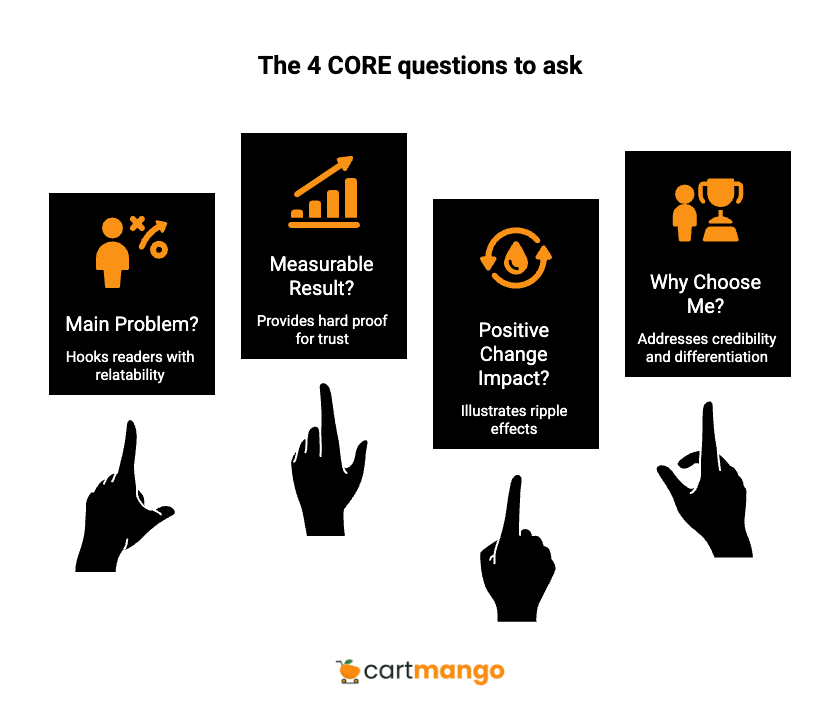
# | Core Question | Why It’s Mandatory |
|---|---|---|
1 | “What was the main problem or goal that made you seek coaching?” | Hooks readers with a relatable starting point. |
2 | “What measurable result or breakthrough have you achieved since we started?” | Supplies hard proof prospects trust. |
3 | “How has this positive change affected your day-to-day life or business?” | Shows ripple effects readers can picture. |
4 | “Why did you choose me over other coaching options?” | Addresses the credibility gap and differentiates you. |
1/ What was the main problem or goal that made you seek coaching?
This question hooks readers with a relatable starting point. When prospects see themselves in your client’s initial struggle, they lean in. The pain or ambition becomes their entry point into the transformation story.
Clients would say “I wanted to grow my business” or “I felt stuck.” These answers meant nothing to prospects because they lacked emotional weight.
Push for specifics.
“What was keeping you up at night?” or “What finally pushed you to seek help?” The answers reveal urgent, relatable problems.
2/ What measurable result or breakthrough have you achieved since we started?
Hard proof builds trust faster than emotional stories alone. Numbers, milestones, or concrete achievements give skeptical prospects something solid to evaluate.
Don’t limit this to revenue gains. Confidence scores, time saved, stress reduction, team feedback, or relationship improvements all count.
Different prospects care about different metrics.
3/ How has this positive change affected your day-to-day life or business?
This paints the ripple effect.
- Better sleep
- Improved relationships
- Increased productivity
- Reduced anxiety
- Etc.
These details help prospects picture their own transformed future.
The everyday impact can matter more than the primary goal. A client might hire you for business growth but discover the real win is family time. These unexpected benefits become powerful selling points.
4/ Why did you choose me over other coaching options?
This addresses the credibility gap without bragging. Your client becomes your advocate, explaining their decision process. It’s like getting a mini case study for your unique value proposition.
The question also handles objections before they surface. Maybe your rates are higher than competitors. When clients explain why they chose quality over price, prospects understand the premium.
–
Think about it this way.
- Question 1 gets them remembering their pain.
- Question 2 gives you numbers to quote.
- Question 3 paints the after picture.
- Question two positions you as the obvious choice.
If you’re running short on time, stick to these 4. They capture the complete transformation arc in under ten minutes.
Need richer context? Layer in the additional questions below, but never skip these 4 foundation stones.
8 Extra Testimonial Questions (optional)
Sometimes you need more depth. Maybe your client loves sharing details, or you’re crafting a comprehensive case study. These questions add layers without losing focus.
Mix and match based on what excites your client most. Remember, the 4 core questions stay locked in place.
1/ Describe your biggest “aha” moment during our work together.
Breakthrough moments stick in memory. When clients recall these lightbulb instances, their excitement becomes contagious to prospects reading later.
I’ve noticed something interesting about aha moments. They often happen between sessions, not during them. Clients will mention insights that hit while driving, showering, or walking the dog. These organic breakthroughs feel more authentic than classroom revelations.
2/ Which tool, exercise, or framework helped you most?
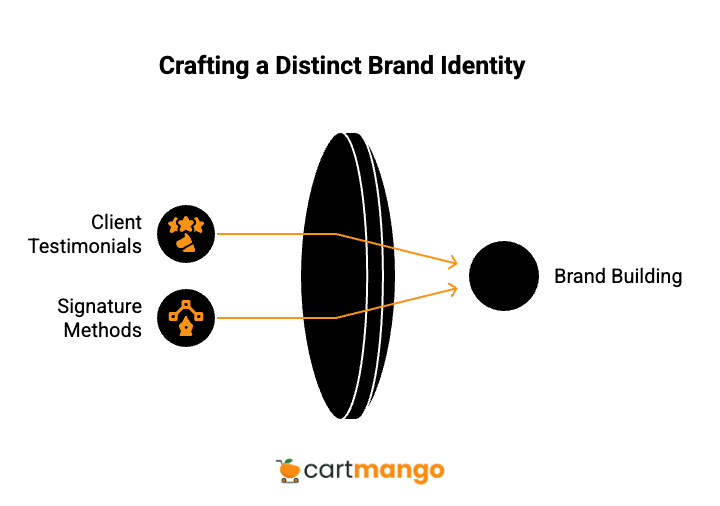
Prospects want proof your methods work beyond motivation and accountability. When clients credit specific tools, it validates your systematic approach.
This question also builds your brand. If multiple clients mention your “confidence scaling exercise” or “priority matrix system,” you can market these frameworks as signature methods.
3/ What surprised you about the coaching experience?
Here’s a content gap most competitor websites miss completely. Surprise elements challenge expectations and address hidden objections.
Maybe your client expected boring homework but found sessions energizing. Perhaps they thought coaching would be touchy-feely but appreciated your practical focus. These revelations reshape prospect assumptions.
4/ Where do you think you’d be now if you hadn’t invested in coaching?
This creates urgency without sounding pushy. Clients paint their own nightmare scenario, helping prospects realize inaction costs more than investment.
Clients imagine staying stuck, burning out, or missing major opportunities. When they verbalize these consequences, prospects feel the weight of delay.
5/ How has this change impacted people around you – team, family, or clients?
Ripple effects prove transformation runs deep. When spouses notice less stress, teams report better leadership, or clients praise improved service, the credibility multiplies.
These third-party validations carry special weight. Family members and colleagues have no reason to exaggerate. Their unsolicited feedback becomes your strongest social proof.
6/ What was the most unexpected benefit you gained?
Bonus value can become your compelling selling point.
Clients might seek business growth but discover work-life balance. They want better leadership but find personal confidence.
I love these surprise benefits because they expand your market. Someone reading about unexpected stress reduction might hire you for anxiety management, even though you market business coaching.
7/ How would you describe the return on your investment so far?
ROI conversations give you quotable proof points. Some clients calculate exact dollar returns. Others measure time saved, opportunities gained, or problems avoided.
Let them choose their own metrics. A parent might value family time more than revenue. An executive might prioritize team harmony over profit margins. Different returns appeal to different buyer segments.
8/ Is there anything else you’d like to add that future clients should know?
This open-ended closer catches gold you might otherwise miss.
Clients often save their most compelling thoughts for last, when they feel relaxed and heard.
Some share advice for future clients. Others offer encouragement for people on the fence. These authentic, unrehearsed moments often become your most powerful testimonial snippets.
–
When weaving these questions into conversations, natural flow beats rigid structure. Listen for energy and enthusiasm. If a client lights up discussing framework tools, explore that thread. If they seem passionate about family impact, dig deeper.
Hidden-Gold Follow-Up Questions
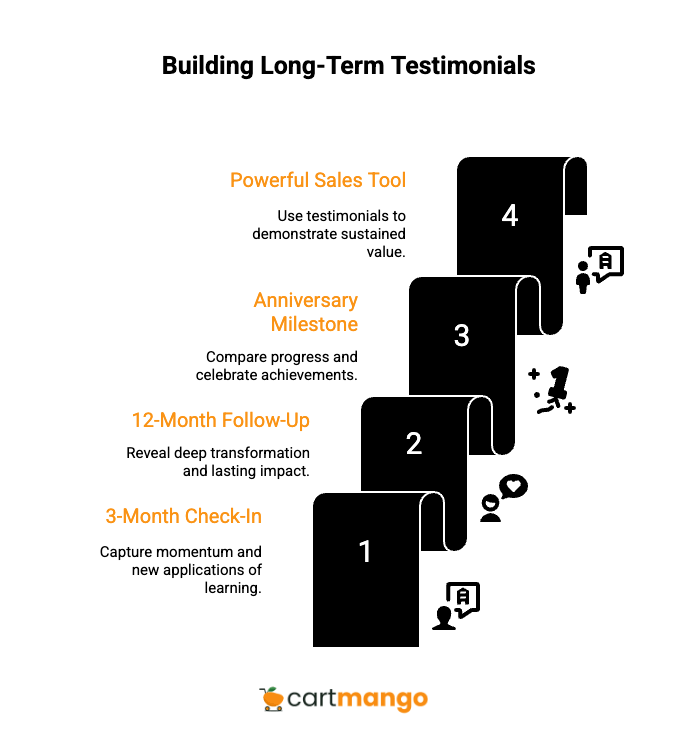
Most coaches collect testimonials once and consider the job done. That’s leaving serious money on the table.
Element | Details | Value for the Coach |
|---|---|---|
Purpose | Capture long-term ROI through follow-up check-ins. | Demonstrates sustained impact and keeps testimonials fresh. |
When to Follow Up | – 3 months post-program – momentum proof – 12 months post-program – long-term transformation – Anniversary of major milestone | Timed touch-points boost response rates and relevance. |
Prompts | – “What additional results have surfaced since our last session?” – “Has the initial breakthrough rippled into other areas of life/business?” – “What metric best proves continued progress?” – “Any new surprises or milestones worth sharing?” – “If you met your past self, what would you say about the journey so far?” | Uncovers new proof points and emotional hooks. |
These long-term testimonials can become your powerful sales tools. They prove your impact doesn’t fade when the program ends. They show prospects that coaching creates lasting change, not temporary motivation.
The timing matters more than you might expect. Three-month check-ins catch momentum. Clients are still implementing what they learned, often discovering new applications. Twelve-month follow-ups reveal deep transformation. Initial changes have taken root and expanded.
Anniversary dates work well too. If someone achieved a major breakthrough during month two of your program, check in on the same date next year. The progress comparison often amazes both of you.
The 15-Minute “Testimonial Capture” Method
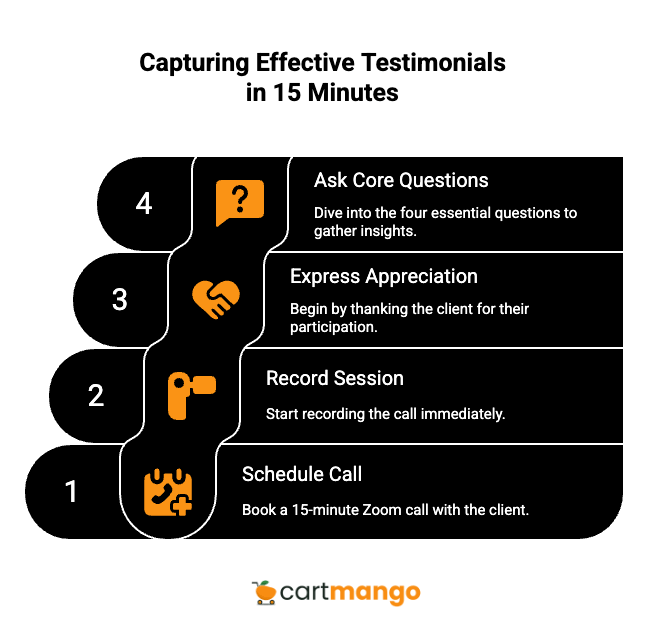
Here’s where most coaches mess up completely. They send long email questionnaires and wonder why response rates stink worse than a gym bag left in a hot car.
Speaking feels effortless for busy clients. It captures genuine emotion that written responses cannot match. The tone, pace, and energy translate directly to prospects watching later.
Here’s what I suggest:
- Book a 15-minute Zoom call during the week following your client’s final session. Schedule it when they’re feeling successful and energized.
- Hit record the moment you start talking.
- Begin with warm appreciation for their participation. Then dive straight into the four core questions.
If time allows, sprinkle in 2 or 3 additional questions from the expanded list. Keep the energy high and conversational. Avoid interviewer mode – stay friendly and curious.
The bonus payoff hits you twice:
- First, the video becomes an instant social media reel for your website hero section.
- Second, the auto-transcript gives you raw material to craft punchier text testimonials.
Use a simple tech stack: Zoom for the call, Fathom for recording and transcription. Both tools offer a free plan.
Always secure explicit consent before recording starts. Say something like: “I’d love to use parts of our conversation to help other potential clients understand what coaching can accomplish. Are you comfortable with me recording this for both video clips and written testimonials?”
Most clients actually prefer this method over written questionnaires. It feels like a friendly celebration call rather than homework. Plus, you’re positioning their success as a way to help others, which appeals to most people’s generous nature.
One warning: don’t over-coach their responses. If they stumble over words or pause to think, that’s human and authentic. Perfect polish makes testimonials feel scripted and fake.
Repurpose & Amplify
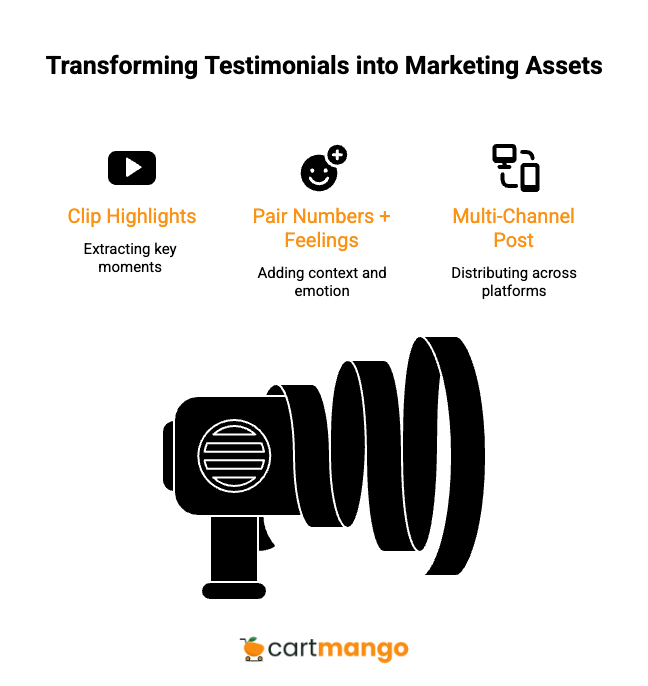
Raw testimonial footage resembles an uncut diamond – valuable but not yet brilliant. The real magic happens when you polish and distribute strategically across multiple channels.
Step | Tactic | Outcome |
|---|---|---|
1. Clip Highlights | Trim 30-45 second “wow” moments from longer recordings. | Snackable social-proof reels perfect for hero sections, ads, and social posts on Instagram, X, and Facebook. |
2. Pair Numbers + Feelings | Caption examples: “38 percent revenue jump, stress down to 2/10.” | Converts skeptics who need both logical proof and emotional connection. |
3. Multi-Channel Post | – Website hero banner – LinkedIn carousel posts – Email nurture sequences – Social posts across Instagram, X, and Facebook | Extends testimonial reach without additional filming or client time. |
Sub-60-second videos get 66-68% higher completion rates (Source: Umbrex).
The caption formula matters more than most coaches realize:
- “Sarah increased revenue 40 percent” sounds clinical and distant.
- “Sarah went from staring at overdue bills every morning to celebrating a 40 percent revenue jump while finally sleeping through the night” creates a movie scene in prospects’ minds.
Numbers alone don’t sell – stories do. When you pair concrete results with emotional context, skeptical prospects can picture both the logical and feeling benefits of working with you.
Distribution strategy separates successful coaches from those struggling to fill programs. Your website hero section should rotate maximum three testimonials. More creates decision paralysis. Less looks like you lack social proof.
Email nurture sequences work best when you match testimonial themes to subscriber pain points. Send revenue-focused clips to business owners. Share work-life balance stories to overwhelmed executives. Tailor the proof to the prospect’s primary concerns.
Social media amplification requires platform-specific adaptation. LinkedIn prefers professional transformation stories. Instagram responds to visual before-and-after contrasts. Facebook audiences engage with family and relationship impact stories.
Ethical & Legal Consent Checklist
Getting sued over testimonial usage ranks high on anyone’s nightmare list. These protection steps maintain client trust while keeping you legally safe.
Start with a clear email template requesting permission. Include specific checkbox language covering video usage, written quotes, and future marketing materials. Be transparent about where testimonials might appear – website, social media, sales presentations, or advertising.
Remind clients they can withdraw consent anytime. This builds trust and demonstrates respect for boundaries. Most clients appreciate the transparency and rarely revoke permission once given.
Here’s a template you can use:
“I give permission for [Coach Name] to use my testimonial in video format, written quotes, and marketing materials including but not limited to website, social media, email campaigns, and promotional presentations. I understand I can revoke this permission at any time by emailing [contact].”
GDPR compliance matters even for US-based coaches. Many clients work internationally or for global companies. The official GDPR guide outlines current requirements for data protection and consent management.
The ICF coaching ethics page covers professional and ethical standards as coaches.
Store consent records in a secure system. Use a simple spreadsheet tracking client names, dates, consent types, and any special restrictions. This documentation protects you if questions arise months or years later.
Document any usage restrictions clients mention. Some prefer first names only. Others want industry details omitted. A few request geographic anonymity. Respecting these boundaries builds long-term trust and referral potential.
Maximizing Your Coaching Business Through Strategic Testimonial Display
Your coaching business thrives when prospective clients can visualize success before their first coaching sessions. The way you present positive testimonials shapes how potential clients perceive your coaching services and coaching process.
A dedicated testimonial page transforms casual website visitors into committed clients. This isn’t just another page buried in your site navigation – it becomes a powerful marketing tool that showcases your coaching journey with real people achieving real results.
Here’s what separates high quality testimonials from the rest. Your dedicated testimonial section should feature diverse coaching testimonial questions that reveal different aspects of your coaching style. Life coaching testimonials work differently than career coaching examples. Professional growth stories resonate with executives, while personal life transformations speak to individuals seeking work-life balance.
When gathering testimonials from existing clients and past clients, focus on creating meaningful testimonials that speak directly to your target audience. A brief testimonial highlighting leadership skills might attract corporate clients. A short video testimonial showcasing career development could draw job seekers and career changers seeking new clients like themselves.
The key lies in presenting these testimonials in a considered and informative manner. Your testimonial page should help future clients understand not just what you accomplish, but how your coaching relationship unfolds. This informative manner builds trust before prospects ever book a discovery call.
As I mentioned earlier, video testimonials carry special weight in today’s coaching landscape. When past clients share their coaching journey on camera, prospective clients witness authentic emotion and genuine transformation. These powerful client testimonials become your best marketing assets across social media platforms and help generate positive reviews that attract more prospects.
Don’t limit testimonials to your website. Share them strategically to generate word of mouth referrals. A compelling testimonial example posted on LinkedIn with a strategic website link might attract corporate clients seeking an exceptional trainer who has presented training for leadership development. The same story shared in a personal manner on Instagram could resonate with individuals pursuing personal commitments and lifestyle changes.
Systematizing Testimonial Collection Across Your Coaching Practice
Most coaches stumble when they ask for a testimonial without a clear system. Whether you offer life coaching, career coaching, or executive development, you need consistent processes that make client feedback feel natural rather than forced.
The timing of when you request testimonials can make all the difference between enthusiastic responses and awkward silence. I’ve discovered that the best testimonials emerge when clients experience measurable benefits they can articulate clearly. This might happen mid-program when they achieve a breakthrough, or months later when long-term changes become obvious in their professional life.
Your coaching testimonials should reflect the full spectrum of transformation you facilitate. Life coaching testimonials might focus on personal relationships and inner confidence. Career coaching stories typically highlight professional growth, leadership style development, and advancement opportunities. Both types serve different segments of your potential client base.
Create testimonial templates that guide clients toward specific details without feeling scripted. A valuable practice involves offering clients multiple ways to share feedback – written responses, recorded videos, or brief testimonial conversations during your final coaching sessions.
Consider your coaching relationship duration when gathering testimonials. Short-term clients might provide powerful snapshots of immediate breakthroughs. Long-term coaching relationships often yield deeper testimonials about sustained change across both professional and personal life areas.
The most effective approach involves making testimonial collection feel collaborative rather than extractive. When you express gratitude for their participation and explain how their story helps future clients, most people respond generously. Frame it as helping others who face similar challenges, and you’ll discover that exceptional clients become enthusiastic advocates.
Remember that low quality testimonial responses often result from poor timing or unclear requests. When you approach testimonial gathering in a personable manner and offer clients instant access to simple formats, response rates improve dramatically. A few words of authentic appreciation can generate more powerful testimonials than lengthy questionnaires that feel like homework.
Your Turn
Strategic questions paired with a friction-free 15-minute call transform client stories into conversion engines that work while you sleep.
The 4 core questions capture transformation arcs that prospects recognize and trust. Additional questions add depth without overwhelming busy clients.
Follow-up conversations after 3 and 12 months uncover long-term proof points that separate you from competitors making temporary change promises. Most coaches miss this opportunity completely.
The 15-minute recorded call method removes friction for clients while giving you professional video and transcript materials. Repurposing frameworks multiply your testimonial investment across websites, social media, and email campaigns.
Legal protection through proper consent keeps you safe while building client trust.
Now that you know what to do to get sales-pulling testimonials, which client would you approach first?
Related
- Sellfy vs Payhip: The Recurring Revenue Prison (2026)
- Podia vs Gumroad: The Recurring Revenue Handcuffs (2026)
- SendOwl vs Gumroad: The Recurring Revenue Black Hole (2026)
- Gumroad vs Sellfy: The Vendor Lock-in Cage (2025)
- Gumroad vs Payhip: The Hidden Trap for Creators (2025)
- ThriveCart vs SamCart – The Subscription Hostage Trap (2025)
- 8 ThriveCart Alternatives & The Lifetime Pricing Paradox (2025)
- 8 SamCart alternatives + Subscription hostage (2025)
- The GENTLE Method: Soft marketing for creators
- How Far in Advance Should You Promote a Webinar?
